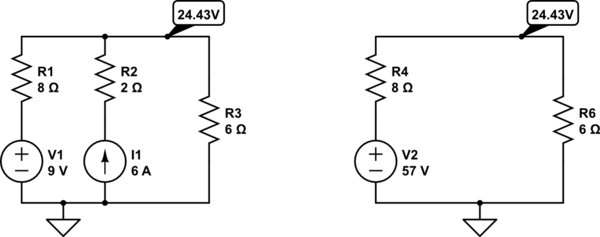I've been trying to solve a circuit by aplying thevening (the following one)
I've obtained 11,4V but I've seen to be wrong.
Can anybody help me?
I've been trying to solve a circuit by aplying thevening (the following one)
I've obtained 11,4V but I've seen to be wrong.
Can anybody help me?
In order to get Thevenin voltage at terminals A-B you have to remove your load resistor R3, which leaves you with only a mesh consisting in sources V1, I1, and resistors R1 and R2. Since you have only one loop, with net current of 6A (due to I1) you'll have a voltage drop given by: \$V_{AB} = V_1 + V_{R_1} = 9V + R_1*I_1=9V + 8\Omega*6A= 9V + 48V = 57V\$

simulate this circuit – Schematic created using CircuitLab
Now, to obtain Thevenin resistance you should "turn off" independent sources (short circuit V1 and open circuit I1), which leaves you only the R1 resistor as Thevenin resistor. Finally your Thevenin equivalent is a 57V source in series with a 8ohm resistor (thevenin) and your original 6ohm load resistor.
